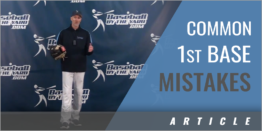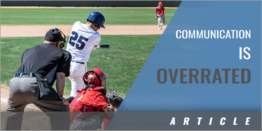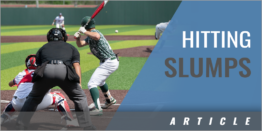| Batting tee drills ... that doesn't involve hitting!
The batting tee is my pick for the World's Greatest Baseball Training Invention Award. ...and not just for hitting! Here are some other uses: Shortstop - Across the Bag Drill: A common mistake for shortstops is unnecessarily catching a double play ball directly over the bag. To target this, a batting tee can come in handy. Place the tee with a ball on it about 1 - 3 feet on the second base side of the bag. Using just bare hands, have the shortstop approach the bag as normal, cross over the bag to pick the ball off the tee, and continue to throw to first base. This develops the habit of cacthing the ball on the second base side as described in the linked post above. Move the tee around and raise/lower the ball to mimic all types of feed locations. Doing so allows the shortstop to practice making quick adjustments on bad feeds. Long-arm Pitching Drill: This drill helps pitchers who short-arm the ball a bit too much. This drill works best when pitchers start in the stretch position. Put a ball on a tee that is placed directly behind the pitching rubber. The height of the ball should be the height of the pitcher's hand when hanging straight down next to the leg. The pitcher comes set, lifts his leg, and separates his hands as normal. The throwing hand extends down, picks up the ball off the tee, and then continues with the throwing process from there. This helps the pitcher develop the feel of lengthening his arm to get the most out of it. This stretch/throwing motion cannot really be done at full speed since the pitcher has to be looking at the ball to pick it off the tee. Accuracy Drill: Sometimes a pitcher does not have the luxury of throwing to a catcher and must throw into some kind of net or wall. If that's the case, put a ball on a tee, place the tee in the location you want to work on - low and away, up and in, etc., and try to hit the ball off with your pitch (hitting the tee doesn't count!). This helps a pitcher learn to focus on a smaller target for better accuracy. Feed Footwork Drill: Some middle infielders struggle with the footwork associated with fielding a ball and starting a double play feed to second base. To help, place a ball on a tee somewhere in front of the fielder. Using just his bare hands, have the fielder get set and charge as if the ball is a ground ball. The fielder sets his feet, picks the ball off the tee and throws to second. This drill eliminates the ground ball part and allows the fielder to focus entirely on the footwork and throw. Move the tee around and raise/lower the tee to work on multiple types of ground balls. Catching Lane Drill: Base Running Lane Drill: Of course, the best thing about tee drills is that the player can do all of them by himself if necessary! Have any batting tee (non-hitting) drills of your own? Send them to:
|
|
About the Author... |
|
|
| I am proud to come from a baseball family. My grandfather's (Mother's side) name was Hal Kelleher. He pitched for the Philadelphia Phillies in the 1930's. My father was a long time baseball coach at the youth, high school, and college levels. He even had a chance to coach in the College World Series while an assistant at Temple University in 1972. While in the military service, my father was stationed at Fort McPherson outside of Atlanta, Georgia which had a general that was a baseball fanatic. He did everything he could to bring major league players who were drafted into the Army to Fort McPherson. As a result, Fort McPherson was stacked and won the All-Army Championship as a result. My father played second base on that team. Being around those major leaguers was quite a learning experience for my Dad. He learned about the mental toughness of major leaguers and all the finer points that made them tremendous players. Because of all this, from the time I picked up a baseball, I was learning the finer points of the game. Many of the things I was learning at a young age are not generally taught to players until they get into the higher levels. I was very fortunate to have those good baseball people close to me. When I finished my playing career, I decided I wanted to pass on these finer points to as many players, coaches, and parents as I could. My coaching, this website, and especially my blog are all an attempt to do that. I hope you enjoy what I have to offer. If you are a player or coach, I hope that something you learn from me gives you a better chance at playing and/or coaching at the levels I have been fortunate to experience. Best of luck to all of you on your baseball journey!
Bob McCreary |






